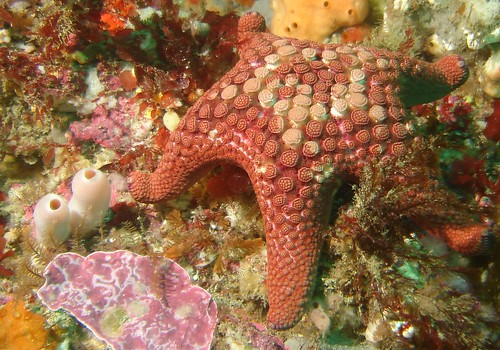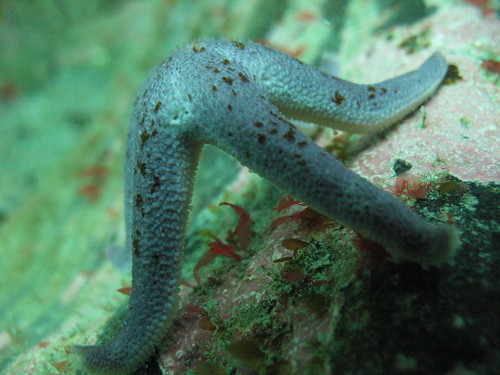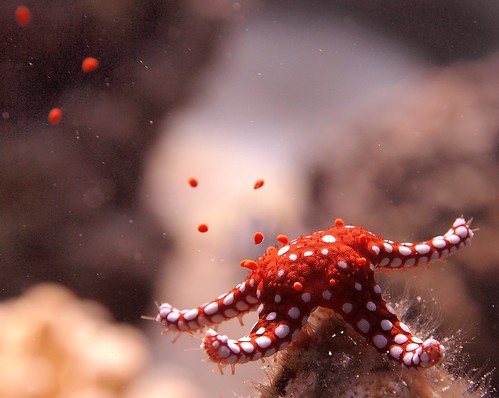 |
| (this image from the book Great British Marine Animals! ) |
How many times in my professional career have I been approached by a diver or some experienced field biologist with a picture of some animal doing an ODD thing. They bring the picture to me and say "By the way, we see this ALL the time. I'm sure its well known".
And it turns out, that it is NOT well known but it sure seems like it ought to be known! Why don't we know???
Case in point- the topic of today's blog-the "spawning posture" observed in sea stars!! This is the odd stance taken by asteroids as they climb up on their tippy toes with disk sticking upward into the water as well-demonstrated by this tropical goniasterid from Japan, Fromia indica
And sometimes they do it en masse!
While I was researching this topic I was quite surprised to learn that there haven't been ANY studies on how doing this weird "step up on the tippy toes" posture helps or otherwise affects the animal during spawning
One sees this posture in cold water species such as the North Pacific Pisaster brevispinus
(Note that the two images below courtesy of Jan Kocian Photography-used with his permission)
and Evasterias troschelii

and just to show that its apparently not taxon specific, here is the solasterid Solaster stimpsoni
with more pix of this species spawning here for good measure...
But the behavior is seen in MANY other temperate-cold water North Pacific species including Pisaster ochraceus, and even the large Pycnopodia helianthoides (kind of)!
The posture is ALSO seen in tropical species, in addition to Fromia above, we also have examples such as this cushion star, Culcita novaeguineae "standing" up on its arm tips!!
here's the oreasterid Protoreaster nodosus

and this large multi-rayed Luidia from New Caledonia. Its worth noting that this species is about 1 to 2 feet across! So, one of these standing up is uh...kind of creepy..

(From Catala's Treasures of the Tropic Seas)
AND as long as we are on the topic.. ophiuroids (i.e., brittle stars) ALSO display this behavior!
Here's some small green tropical Ophiactis doin' their thing! (best seen in the one on the left)
One might ASSUME that it provides a platform for the gametes as they are emitted, higher into the water column.
But we actually don't know! What one might infer or assume might not (and sometimes just isn't) the case.
People are always surprised when I tell them that.
Often times, you have some behavior or other biology going on-but we just haven't scratched the surface of understanding some of these familiar but surprisingly poorly known species...
And what seems "obvious" to some people becomes a question once you think about it.
For example, why do sea stars NOT always assume such a posture?? Some species, such as this Australian Acanthaster planci (Crown of Thorns) seem to just go for it without the standing on their toes action!

(from the Australian Museum website . Photo by Lyle Vail and Anne Hoggett)
Interestingly there appears to be variation in behavior even within a single species for this behavior!
For example, these images of Ochre stars (Pisaster ochraceus) and Sunflower stars (Pycnopodia helianthoides) (click on each to see) also show some variation in posture as gametes being released. (Note that individual gender can't really be determined without sampling the gametes as there is no sexual dimorphism, but I don't know if the individuals in these pictures were sexed.)
There are a HOST of questions that accompany something as important but as unexplained as these spawning postures!
- Does the spawning posture maximize reproductive behavior?
- Why do some species spawn "flat' versus "standing"??
- Does the posture relate to the amount of gametes produced?
- Could this behavior be related to seasonal conditions? Nutrients? Current flow?
- Does behavior vary in cold versus tropical water species??
- Do different species vary in their reproductive posture?? How many species?
So to that marine biology student without a project out there reading this in the middle of the night?? You want to travel?? You want to unravel the mysteries of the stars?? (Well,...sea stars) You want fabulous riches and fame beyond your wildest imaging?
GO DO THIS!!! (please note that riches and fame are exaggerations and are not necessarily applicable or guaranteed)
GO DO THIS!!! (please note that riches and fame are exaggerations and are not necessarily applicable or guaranteed)
And thank me in the Acknowledgments.
So Sayeth the Echinoblog !!
So Sayeth the Echinoblog !!
UPDATE
Here are further species documented with this posture...Do you have a picture of a starfish/seastar doing this? Please let me know in the comments!
Here is Nectria sp. (Goniasteridae) from temperate water Australia. Image by Martin A. Hansen
and possibly this Uniophora granifera from temperate Australia
A Henricia (?) from Ireland. Image by David Riordan
The ophidiasterid Leiaster leachi spawning!
another update...May 17, 2013. Linckia spawning..
Here's a nice shot of Linckia laevigata spawning..from Mabini in the Philippines...
Fromia maybe F. ghardaquana from Egypt. Image by Stephen Childs
Choriaster granulatus (Oreasteridae) Image by John B. Williams





ReplyDeleteHi Chris, I'm slowly building a WP web log re: our travels up the Inside Passage and have just added a link to your site.. hope that's ok.. We're in the Broughton Archipelago this winter and last week I was very excited to photograph Pycnopodia in her spawning posture.. In your Aug 2011 post, you asked if we had such photos.. well, you can see them here...
http://terrylynngold.ca/blog/winter-pursuits/sea-star-antics
Thanks for the exciting info on Asteroids!
All the Best
Terry Lynn Gold
Terry, thank you! Yes! thanks for linking and LOVE the page! Awesome pics!
ReplyDeleteSo far, the couple of times I've seen vermilion stars standing up in the giant pacific octopus exhibit, no spawn/gametes were seen being expelled. Were they practicing? Next time, I'll try to note moon phase and water temp.
ReplyDeleteHi, Great dedication to 1 species of animal that is very rarely researched . Great photos - must be wonderful just to go below the surface to explore the mysteries of the deep. Keep up the GREAT WORK.
ReplyDeleteWow, very interesting. Do you know of anything to suggest they have a season for breeding, or a time? Like at night? I came accross spawning sea cucumbers at night, which also stand up in the water coloumn (far far weirder than Starfish).
ReplyDeleteMy husband and I often do our walks around a nearby marina and we always seem to spot something interesting. Today I spotted a standing starfish!! It intrigued me so much!! I took a photo and looked it up, learning what it all meant. Thanks for sharing your information. I love learning about nature and it’s ways! Wish I could post the picture...🤔
ReplyDelete